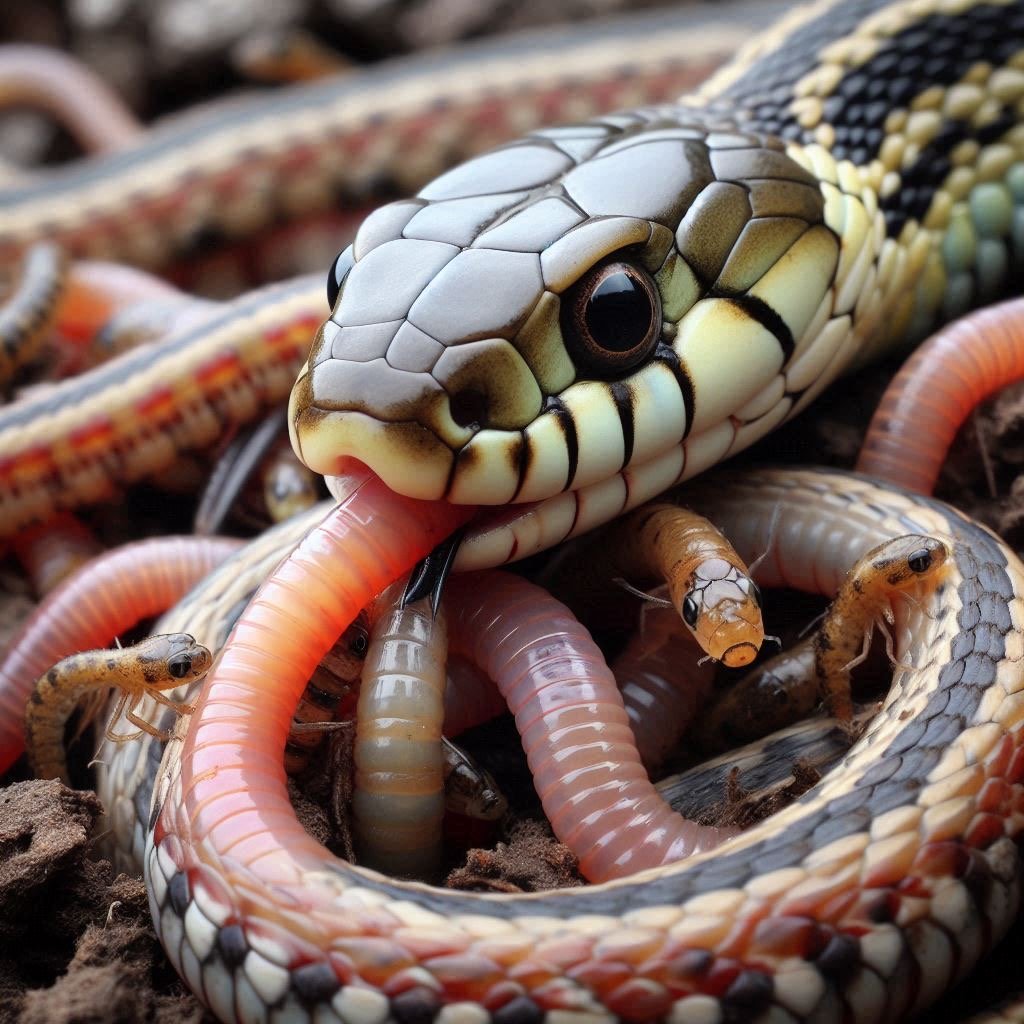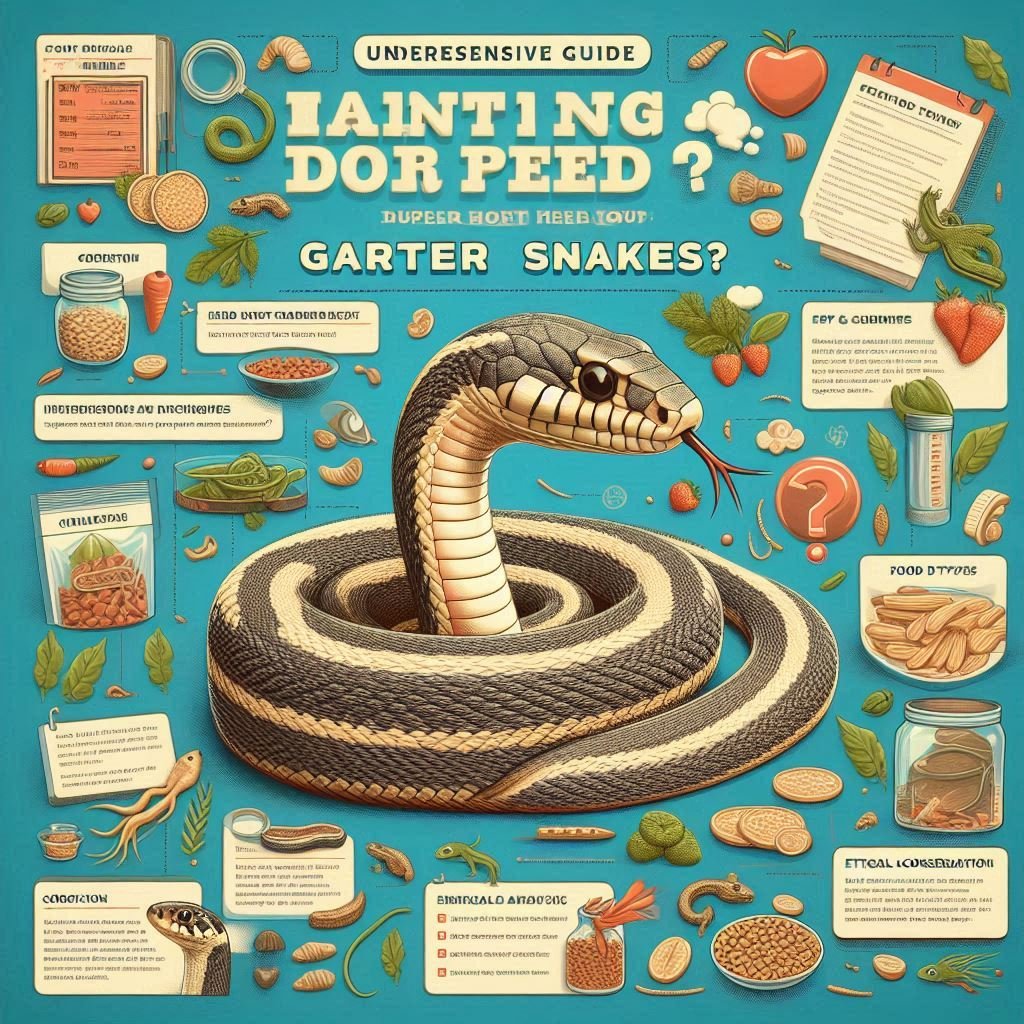Curious about what your pet garter snakes eat? You’re not alone! Many snake enthusiasts find themselves puzzled by the dietary needs of these fascinating creatures.
In this comprehensive guide, we’ll explore the ins and outs of a proper pet garter snake diet, from preferred foods to feeding schedules. Whether you’re a new owner or looking to optimize your snake’s nutrition, we’ve got you covered with expert advice and practical tips.
Understanding the Diet of Pet Garter Snakes
Garter snakes are fascinating creatures with unique dietary needs. In the wild, these slithery friends chow down on frogs and toads, but captive life calls for a different menu.
Pet garter snakes thrive on a diet of mice, earthworms, fish fillets, and even feeder guppies. However, mice reign supreme as the nutritional powerhouse for these reptiles. They provide complete nutrition, eliminating the need for supplements that other food options might require.
Feeding your scaly buddy isn’t just about what’s on the plate, though. It’s also about timing and frequency, which we’ll dive into next.
Preferred Foods and Nutritional Needs
When it comes to pet garter snakes, mice are the gold standard for a balanced diet. These little rodents pack all the nutrients your slithery friend needs to thrive. But hey, variety’s the spice of life, right?
Earthworms, fish fillets, and feeder guppies can also make the menu. Just remember, if you’re not serving up mice, you might need to sprinkle in some vitamins and calcium supplements to keep your snake in tip-top shape.
Wild garters may love frogs and toads, but in captivity, it’s best to stick with readily available options that meet their nutritional needs.
Feeding Frequency and Schedule
Now, let’s talk about when to serve up those tasty morsels. Your garter snake’s feeding schedule depends on its age and preferred diet. Here’s the lowdown:
- Juvenile snakes: Every other day
- Adult snakes: Once a week
- Worm enthusiasts: Twice weekly
- Fish fanatics: Every five to six days
- Mouse munchers: Weekly
Remember, consistency is key. Stick to a regular feeding routine to keep your scaly friend happy and healthy. Just like us, they appreciate a good meal plan!
Historical and Current Feeding Practices
Garter snake feeding practices have come a long way, folks! Back in the 80s and 90s, some keepers actually fed their slithery pals cat food. Can you believe it? Thankfully, we’ve wised up since then.
Today, the gold standard is mice, hands down. They’re nutritionally complete and mimic a garter’s natural prey size. But if your snake’s not keen on rodents, don’t fret! Modern keepers have tricks up their sleeves, like wiggling food with tongs to entice picky eaters.
Some enthusiasts even whip up homemade snake chow, blending whole trout with gelatin. Talk about gourmet!
Evolution of Diet Over the Decades
Garter snake cuisine has had quite the journey! In the early days, keepers were pretty clueless about proper nutrition. Some even resorted to cat food – yikes!
As knowledge grew, so did the menu options:
- 1970s-80s: Mostly fish and worms
- 1990s: Introduction of pinky mice
- 2000s: Shift towards whole prey items
- 2010s-present: Focus on species-specific diets
Nowadays, it’s all about tailoring the diet to mimic what these slithery friends munch on in the wild. We’ve come a long way from those cat food days, and our scaly pals are all the healthier for it!
Current Recommendations for a Healthy Diet
Today’s garter snake gurus swear by a mouse-centric menu. These little rodents pack a nutritional punch that’s hard to beat. But if your slithery friend turns up their nose at mice, don’t panic!
Here’s what the experts suggest:
- Offer a variety of prey items
- Supplement non-mouse diets with calcium and vitamins
- Avoid goldfish and other thiaminase-rich fish
- Consider homemade blends for picky eaters
Remember, consistency is key. Whatever diet you choose, stick to it and watch your scaly pal thrive!
Challenges and Techniques in Feeding Garter Snakes
Feeding garter snakes can be a bit of a puzzle sometimes. These slithery friends can be picky eaters, turning their noses up at perfectly good grub.
One common hurdle is getting them to recognize their food as, well, food. Some snakes need a little extra encouragement. That’s where the wiggle technique comes in handy. Grab those feeding tongs and give that mouse a little dance – it might just trigger your snake’s hunting instincts!
For the extra finicky eaters, some keepers get creative. They whip up special blends or try scenting prey items to make them more appealing. It’s all about finding what works for your unique noodle with legs!
Common Feeding Challenges and Solutions
Even the most experienced snake keepers can hit a few bumps in the road when it comes to feeding time. One of the biggest hurdles? Food refusal. Sometimes these slippery customers just won’t take the bait.
If your garter’s gone on a hunger strike, try these tricks:
- Warm up the prey item
- Offer food at dusk or dawn
- Try different prey sizes
- Use scenting techniques
Remember, patience is key. Don’t force-feed your snake – it’s stressful for both of you. If problems persist, a vet visit might be in order. After all, better safe than sorry when it comes to your scaly friend’s health!
Innovative Feeding Techniques by Experts
Snake whisperers have cooked up some clever tricks to tempt fussy eaters. Alan Francis, a British garter guru, concocted a gourmet blend of whole trout and gelatin – talk about snake fine dining!
Some experts swear by the “braining” technique (not for the squeamish). It involves exposing the prey’s brain to release enticing scents. Yum?
Others get crafty with scent transfer, rubbing prey items with fish or frog essence to trick snakes into thinking they’re getting their wild favorites. It’s like snake aromatherapy!
Remember, these are pro moves. Always consult a vet before trying anything new with your slithery friend.
Comparative Analysis of Food Types

When it comes to garter snake chow, not all grub is created equal. Mice take the crown, offering a nutritional powerhouse that’s hard to beat. They’re the complete package, no extra vitamins needed.
Fish and worms? They’re like the fast food of the snake world – tasty but lacking. You might need to play supplement chef if these are on the menu.
Here’s the lowdown on food types:
- Mice: Top-notch nutrition, natural prey size
- Fish: Watch out for thiaminase, can be risky
- Worms: Easy to find, but nutritionally incomplete
Remember, what works for one snake might not work for another. It’s all about finding that perfect balance!
Benefits of Mice Over Fish and Worms
Let’s face it, mice are the nutritional superstars in the garter snake world. They’re like a complete meal deal – no extra sides needed!
Fish and worms? They’re more like snacks that leave your snake wanting more. Here’s why mice take the cake:
- Packed with essential nutrients
- Natural prey size for easy digestion
- No need for vitamin supplements
- Lower risk of nutritional deficiencies
Plus, mice don’t come with the thiaminase troubles that some fish bring to the table. It’s a win-win for your slithery friend’s health and your peace of mind!
Risks Associated with Non-Mouse Diets
While variety might spice up your life, it can spell trouble for your garter snake. Non-mouse diets come with their fair share of risks. Fish fanatics, beware! Some swimmers pack a nasty surprise called thiaminase, which can wreak havoc on your snake’s health.
Worm-only diets? They’re like living on junk food – tasty but lacking. Your scaly friend might end up with nutritional deficiencies, leading to health issues down the road.
And let’s not forget about size matters. Prey that’s too small might leave your snake feeling hangry, while oversized meals can cause digestive distress. Stick to mouse-sized portions for a happy, healthy noodle!
Legal and Ethical Considerations
Keeping garter snakes as pets isn’t just about feeding them right—it’s also about staying on the right side of the law. Did you know snagging a wild garter for your terrarium could land you in hot water? Yep, it’s often illegal to catch these slithery friends from the wild.
But the ethical dilemmas don’t stop there. Choosing your snake’s diet comes with its own moral maze. Is it okay to feed live prey? What about the environmental impact of sourcing certain foods? These are questions that’ll make any responsible snake owner scratch their head.
Regulations on Feeding Wild-Caught Snakes
Thinking of snagging a wild garter for your terrarium? Hold your horses! It’s not just about what you feed them, but where they come from. Many places have strict regulations against catching wild snakes for pets.
If you’ve somehow ended up with a wild-caught garter (no judgment, we’ve all been there), feeding them can be tricky. They might turn their nose up at captive prey, preferring their usual wild menu. In these cases, it’s crucial to consult a reptile vet or experienced keeper.
Remember, the goal is to transition them to a captive diet safely and legally.
Ethical Implications of Diet Choices
Feeding your garter snake isn’t just about nutrition—it’s a moral minefield! The ethical considerations can make your head spin. Should you opt for pre-killed prey or go live? It’s a touchy subject among snake enthusiasts.
Then there’s the environmental angle. Sourcing sustainable food options might mean ditching those convenient frozen rodents for locally-sourced alternatives. And let’s not forget about the welfare of feeder animals. It’s enough to make you question every morsel you offer your scaly friend.
Ultimately, it’s about finding a balance between your snake’s needs and your own ethical compass.
FAQs
Garter snakes benefit from a varied diet to ensure proper nutrition. Juvenile snakes can eat a combination of feeder guppies, minnows, earthworms and fish fillet pieces; feed the juvenile snakes every other day. Mature snakes should eat small rodents, such as mice or pinkies, but they only need food once a week.
These snakes are small and swallow their prey whole so they will eat anything they can overpower. This includes snails, earthworms, leeches, small fish, grasshoppers, and other insects. Occasionally they will eat small birds and rodents.
A garter snake seldom will be able to feed on a mouse or rodent. These snakes also feed on carrion, especially dead worms. In the home garden, earthworms and grubs are by far their No. 1 food (Figure 7).
Although often considered “common” and “uninteresting” to the North American reptile hobby, garter snakes make hardy, manageably-sized, interesting pet snakes. Expect your pet to live 10+ years with good care.
Conclusion
Feeding your pet garter snake doesn’t have to be a puzzle. Mice reign supreme as the nutritional powerhouse, but alternatives exist for picky eaters.
Remember to stick to a consistent feeding schedule and always prioritize your snake’s health and well-being. As you embark on your garter snake care journey, stay informed and don’t hesitate to consult experts when needed.
Ready to become a garter snake feeding pro? Slither into action and give your scaly friend the diet they deserve!













